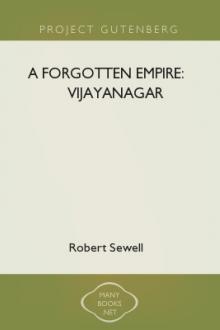A Forgotten Empire: Vijayanagar by Robert Sewell (short story to read TXT) 📕

- Author: Robert Sewell
- Performer: -
Book online «A Forgotten Empire: Vijayanagar by Robert Sewell (short story to read TXT) 📕». Author Robert Sewell
“After that, Narasymgua was raised to be king…. And as he had much power and was beloved by the people, thence-forward this kingdom of Bisnaga was called the kingdom of Narsymga.”
The problem of Narasimha’s relationship to the old royal line has never yet been satisfactorily solved. He belonged to a family called SALUVA, and we constantly hear, in the inscriptions and literary works of the time, of powerful lords who were relations or descendants of his. Thus our chronicle has much to say about the Saluva Timma, whom Nuniz calls “Salvatinea,” who was minister to King Krishna Deva Raya. An inscription of the Saka year 1395, which corresponds to A.D. 1472 — 73, speaks of Narasimha as a great lord, but a great lord ONLY,[168] and so does another of A.D. 1482 — 83.[169] In one of A.D. 1495 — 96, however,[170] he is called “MAHA-RAYA,” or the “king.” But although the exact date of the usurpation and the exact relationship of the usurper to the deposed king may be difficult to ascertain, the fact remains that Narasimha actually became sovereign about this time, that Muhammadan aggression was stayed by his power and the force of his arms, and that the empire of Vijayanagar was under him once more consolidated.
The account of this period as given by Firishtah differs altogether from that of Nuniz, and gives rise to much confusion and difficulty. And as to the relationship of the succeeding sovereigns, Narasa, Vira Narasimha, Krishna Deva Raya, Achyuta, and Sadasiva, the native inscriptions themselves are totally at variance with one another. Some few points, however, in the general scheme of history of the second dynasty are quite certain, and these may be shortly summarised. The last kings of the first dynasty were recognised down to ABOUT the year 1490 A.D. Narasimha and Vira Narasimha ruled till the accession of Krishna Deva Raya in 1509; Achyuta succeeded Krishna in 1530, and Sadasiva succeeded Achyuta in 1542. The latter was virtually a prisoner in the hands of Rama Raya, the eldest of three brothers, at first nominally his minister, but afterwards independent. The names of the other brothers were Tirumala and Venkatadri. These three men held the government of the kingdom till 1565, when the empire was utterly overthrown by a confederation of the five Muhammadan kings of the Dakhan, already mentioned, at the battle of Talikota — so-called — and the magnificent capital was almost wiped out of existence.
With these few facts to guide us, we turn to the chronicles of Nuniz and Firishtah, trying in vain to obtain some points of contact between them as to the origin of the second dynasty — some clue which will enable us to reconcile differences and arrive at the real truth. If we are to be guided purely by probabilities, it would seem that the history given by Nuniz is likely to be the more accurate of the two. His chronicle was written about the year 1535, during the reign of Achyuta; he lived at the Hindu capital itself, and he gained his information from Hindu sources not long subsequent to the events related. Firishtah did not write till about A.D. 1607, was not in any sense a contemporary recorder, and did not live amongst the Hindus, but at the court of Nizam Shah at Ahmadnagar. The lengths of reigns, however, as given by Nuniz do not tally with the dates which we obtain from sources undoubtedly reliable.
Nuniz has it that Virupaksha’s son “Padearao,” the last of the old line, fled from the capital when the usurper Narasimha seized the throne; that the latter reigned forty-four years, and died leaving two sons. These youths being too young to govern, the dying king intrusted the kingdom to his minister, Narasa Naik, and both the princes were murdered. Narasa seized the throne, and held it till his death. The length of his reign is not given. His son, “Busbalrao” (? Basava Raya), succeeded, and reigned six years, being succeeded by his brother, the great Krishna Deva Raya. Now we know that Krishna Deva Raya began to reign in A.D. 1509. This gives 1503 for the date of the accession of his predecessor, “Busbal.” If we allow five years for the reign of Narasa — a pure guess — we have his accession in 1498 A.D., and the forty-four years of Narasimha would begin in A.D. 1454; but this would apparently coincide with the reign of Mallikarjuna, son of Deva Raya II. It is perhaps possible that in after years the usurper Narasimha’s reign was measured by the Hindus from the time when he began to attain power as minister or as a great noble, and not from the date when he actually became king; but this is pure conjecture.
Firishtah mentions a certain “Sewaroy” as being raya of Vijayanagar in 1482, shortly before the death of Muhammad Shah Bahmani. Speaking of the new sovereign of Bijapur, the first of the Adil Shahs, in 1489, the historian tells us that the Adil’s rival, Kasim Barid, asked the then minister of Vijayanagar for aid against the rising power of his enemy;[171] and that “the Roy being a child, his minister, Heemraaje,[172] sent an army” and seized the country as far as Mudkal and Raichur. This occurred in A.H. 895, which embraces the period from November 1489 to November 1490. “HEEMraaje,” therefore, is probably for SIMHA or Narasimha Raja, or perhaps for Narasa, otherwise called Vira Narasimha.
Firishtah also gives another account of the same event. According to this, the Adil Shah, hearing of dissensions in the Hindu capital, marched, apparently in 1493, against Raichur, when Heemraaje, having settled these dissensions, advanced “with the young Raya” to that city. A battle ensued, in which Heemraaje was defeated; and the young king being mortally wounded, and dying before he reached home, Heemraaje seized the government and the country.
There are, furthermore, two other passages in Firishtah dealing with the overthrow of the old dynasty and the accession of “Heemraaje.” One173 runs as follows: —
“Heemraaje was the first usurper. He had poisoned the young Raja of Beejanuggur, son of Sheoroy, and made his infant brother a tool to his designs, by degrees overthrowing the ancient nobility, and at length establishing his own absolute authority over the kingdom.”
The other174 states: —
“The government of Beejanuggur had remained in one family, in uninterrupted succession, for seven hundred years, when Seoroy dying, was succeeded by his son, a minor, who did not live long after him, and left the throne to a younger brother. He also had not long gathered the flowers of enjoyment from the garden of royalty before the cruel skies, proving their inconstancy, burned-up the earth of his existence with the blasting wind of annihilation.[175] Being succeeded by an infant only three months old, Heemraaje, one of the principal ministers of the family, celebrated for great wisdom and experience, became sole regent, and was cheerfully obeyed by all the nobility and vassals of the kingdom for forty years; though, on the arrival of the young king at manhood, he had poisoned him, and put an infant of the family on the throne, in order to have a pretence for keeping the regency in his own hands.[176] Heemraaje at his death was succeeded in office by his son, Ramraaje, who having married a daughter of the son of Seoroy, by that alliance greatly added to his influence and power.”
He then proceeds to describe an event that took place in 1535 or thereabouts, which will be considered in its place.
Writing of the events of the year 1530,[177] we find Firishtah stating that the affairs of Vijayanagar were then in confusion owing to the death of Heemraaje, who was newly succeeded by his son Ramraaje. And this passage helps us definitely to the conclusion that his Heemraaje, or Timma Raja, was the Muhammadan name for the ruler of the state during the reigns of Narasimha, Narasa or Vira Narasimha, and Krishna Deva Raya, the latter of whom died in 1530. Firishtah seems to have confused Narasa’s and Krishna Deva Raya’s powerful minister, Saluva Timma, with Narasimha and Narasa, and made all three one person. “Ramraaje” is mentioned as king by Firishtah from the accession of Achyuta in 1530 down to the year 1565.
Though names and details differ, it will be observed that there is evidently a common basis of truth in the accounts given by Firishtah and Nuniz. Both relate the deaths of two young princes, brothers, the subsequent murder of two other heirs to the kingdom, and the usurpation of the throne by a minister.
With these remarks we turn to the more reliable portion of Firishtah’s narrative.
Yusuf Adil Khan proclaimed himself independent king of Bijapur in A.D. 1489. Shortly afterwards his rival, Kasim Barid, who ultimately became sovereign of the territories of Ahmadabad, in a fit of jealousy called in the aid of Vijayanagar against Bijapur, promising for reward the cession of Mudkal and Raichur, or the country between the two rivers. Narasimha collected the forces of the Hindus, crossed the Tungabhadra with a large army, and after laying waste the country seized the two cities Mudkal and Raichur, which thus once more passed into the possession of Vijayanagar.
Shortly after this, probably about the year 1493 A.D., Sultan Yusuf Adil again marched to recover the lost territory and advanced to the Krishna, but falling ill he halted for two months; and Firishtah gives us the following account of what occurred. This has been already alluded to, but is now given in full: —
“In this interval Heemraaje, having settled his dissensions,[178] advanced with the young roy at the head of a great army to Roijore, which struck terror into the army of Adil Shaw, for whose recovery earnest prayers were offered up by his subjects.” ... (The prayers were answered and the Sultan recovered.)
“Intelligence arriving that Heemraaje had crossed the Tummedra and was advancing by hasty marches, Eusuff Adil Shaw ordered a general review of his army … (and advanced, entrenching his camp a short distance from the Hindus). Several days passed inactively, till on Saturday in Regib 898179 both armies drew out, and in the beginning of the action near five hundred of Adil Shaw’s troops being slain, the rest were disordered and fell back, but were rallied again by the sultan. One of the officers, who had been taken prisoner and made his escape, observed that the enemy were busily employed in plunder, and might be attacked with advantage. The sultan relished this advice and proceeded; when Heemraaje, not having time to collect his whole army, drew out with seven thousand horse and a considerable number of foot, also three hundred elephants. Adil Shaw charged his center with such fury, that Heemraaje was unable to stand the shock. Victory waved the royal standard, and the infidels fled, leaving two hundred elephants, a thousand horses, and sixty lacs of OONS,[180] with many jewels and effects, to the conquerors. Heemraaje and the young roy fled to Beejanuggur, but the latter died on the road of a wound he had received by an arrow in the action. Heemraaje seized the government of the country; but some of the principal nobility opposing his usurpation, dissensions broke out, which gave Adil Shaw relief from war for some time from that quarter.”
The disputed territory between the two rivers once more passed into the hands of the Muhammadans. Goa also remained in the Bijapur Sultan’s possession.
The last historical event in the reign of Yusuf Adil Shah of Bijapur, as narrated by Firishtah, is as follows: —
“In the year 915,[181] the Christians surprised the town





Comments (0)